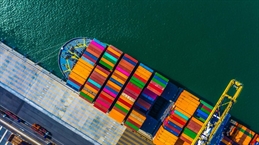
Some of the problems with using public-private partnerships (PPPs) to develop ports in Asia were discussed, along with some possible solutions, during the ASEAN Ports and Shipping Conference in Jakarta.
The issue is vital to the region, particularly to areas where infrastructure is lacking. The Asian Development Bank says that needs in developing Asia and the Pacific will exceed US$22.6 trillion through 2030, or US$1.5 trillion per year if the region is to maintain growth. Those estimates rise to over US$26 trillion, or US$1.7 trillion per year when climate change mitigation and adaptation costs are incorporated.
Against this there is some hope for ports in Southeast Asia, where many projects, usually greenfields, are available, Paul van Eulem, director at Dutch port advisors MTBS, told the conference. This includes Rotterdam building a port at Kuala Tanjung in northern Sumatra, Indonesia, and DP World’s operations at Surabaya.
Developing them by PPPs was “not an easy thing” he said, adding that the infrastructure class was complex, with two factors making it more so.
The scale of projects is getting bigger, causing the risks to also grow. Additionally, the old landlord-tenant model, which kick-started PPPs but which was more straightforward and sometimes involved governments, bringing with it more stability, is now on the wane.
The example van Eulem gave of the current approach was regional and highly topical as a verdict is reportedly due from a Thai court sometime soon on Laem Chabang’s Phase Three.
Here, a 35-year concession was offered on a design-build-finance-operate-maintain (DBFOM) basis. “A very substantial investment development responsibility shifted to the private sector,” he said.
Even more complex and worrying about the Laem Chabang project was what Van Eulem called a “really extraordinarily short” bidding process which saw the offer open initially for two months before being extended by two weeks. Some 32 interested bids were submitted and narrowed to just two. “But it is a process that demonstrates how complex it is to structure and manage the PPP selection process well,” said van Eulem.
His key piece of advice was for investors to appraise possible projects on the basis of the value they can generate, which is best done by sticking hard to three guiding principles: free cash flows, growth and risk.
“If these three elements are protected, you can have successful PPP conditions,” he said. PPP contracts, he added later, need to be “valuable, enforceable and bankable.”
From this flowed some practical advice and considerations.
Operators should also make sure they can manage operational costs. They should, for example, take over existing facilities and allow efficiencies in terms of labour changes and allowing automation, he added.
Growth is very important, and is one of the big things Asia has going for it despite concerns over trade wars and coronavirus disruptions. Indonesia alone, which currently moves 12 million TEUs annually, has substantial room for growth, he pointed out.
Risks also needed to be examined, including dealings with local and national authorities.
“It’s important that governments have a national port plan to create a bit of certainty as to how the sector as a whole will develop,” he said. But local and industry bodies also need to be factored in. “Make sure the port authority is fully mandated and properly governed,” he said.
To make his point hit home, Van Eulem quoted research MTBS has done for the African Development Bank which underscores just how risky such ventures can be. Half of port PPP transactions were delayed by more than 100% of their original planned time and just under a third “don’t make it to the finish line.”
By Michael Mackey
Southeast Asia Correspondent | Jakarta




